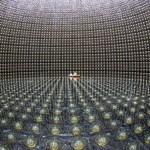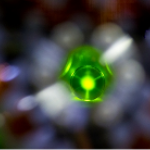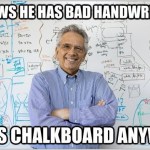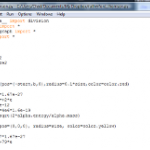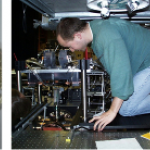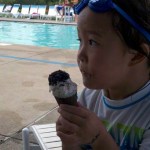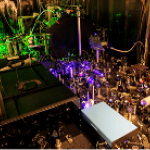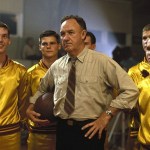
It's gradually becoming clear to me that this blogging thing is old hat. It's a Web 4.0 world now, and we're all just Tmblng through it. So, I need to get with modernity, and start posting the listicles that are the bread and butter of the new social media order. Thus, I give you a web-friendly list of The 15 Most Interesting Force-Carrying Bosons.
The 15 Most Interesting Force-Carrying Bosons
1) The Photon
CGI photon from Physics World (http://physicsworld.com/cws/article/news/2012/aug/10/photon-shape-could… )
(Image source: This Physics World article)
The photon is the carrier of the…
The JCC day care is closed today for one of the fall cluster of Jewish holidays, which means I'm spending the morning with The Pip before Kate comes home to take the afternoon shift so I can teach my class. Thus, this is more of a tab clearance sort of exercise than a thoughtful examination of the underlying issues. But having spent a bunch of time in the recent past on gender gaps of various sorts, these are some recent links that struck me as interesting enough to pass along.
-- Via Crooked Timber, Anca Gheaus offers cheers for being the "token" woman at academic conferences. This is mostly…
One of the chapters of the book-in-progress talks about neutrino detection, drawing heavily on a forthcoming book I was sent for blurb/review purposes (about which more later). One of the little quirks of the book is that the author regularly referred to physicists trying to "trap" neutrinos. It took me a while to realize that he just meant "detect"-- coming from the AMO community, I naturally assume that "trap" means "localize to a small-ish region of space for a long-ish period of time." That is, after all, what I spent my Ph.D. work doing-- trapping cold atoms.
SteelyKid had a rough…
Element: Ytterbium (Yb)
Atomic Number: 70
Mass: Seven "stable" isotopes, from 168 to 176 amu. Two of those are nominally radioactive, with half-lives vastly in excess of the age of the universe.
Laser cooling wavelength: 399 nm and 556 nm.
Doppler cooling limit: 690 μK in the UV and 4.4 μK in the green.
Chemical classification: A rare earth/ lanthanide, one of the hard to distinguish metals in the little island that floats off toward the bottom of the usual presentation of the periodic table, because it's too hard to wedge them in between barium and hafnium. Yet another greyish metal.
Other…
I've finished a first pass through all the regular chapters of the book-in-progress (in addition to those in in this progress report, there's one more in Section 1 about antiques, and three more in Section 4, two about statistics and one about teamwork). I'm starting to do section-level proofreading, looking at blocks of chapters together.
This isn't a step I had to go through with my previous books, for several reasons. One is just that the smaller set of responsibilities I had then made it easier to find contiguous blocks of writing time-- SteelyKid was born after book 1, and The Pip after…
Over at NPR, Adam Frank has an ode to the use of chalk for teaching science, including a bit of warm fuzzy nostalgia:
I have powerful memories of tracking through derivations presented in class when I was a student. When done well, they pinned my attention down. The act of copying what was appearing on the board was a kind of meditation. You had to stay awake and aware, like a man walking across a frozen pond. Let your mind wander for a moment and BAM! You were lost. You couldn't see how the professor had gotten from one step to the next. But keep your focus and you'd be rewarded with that…
Every year since this blog started in 2002, I've marked September 11 with a moment of silence post, as acknowledgement that I don't have anything to say that would be worth sharing with the Internet. This is the very first year that I've had any hesitation about it, because in addition to being a Very Bad Anniversary, this was also a happy day in Chateau Steelypips. This morning, we put SteelyKid on the bus to her very first day of kindergarten.
And, you know, that's worth breaking tradition for. Really, it's as good an excuse as any to retire the tradition altogether-- it's probably time to…
A couple of months back, TED put out a call for auditions for a chance to speak at one of their events. They asked for a one-minute video, and I said "What the hell, I can do that. I need an 'elevator pitch' version of the book-in-progress anyway." This is the result:
So, if you've got a couple of minutes to spare (one minute for the video, plus the better part of a minute for miscellaneous buffering/ network nonsense), check it out. That's as compact a statement of the core argument as I have.
And it was apparently pretty good, because now I get to put together a six-minute version to do…
While I was away for the weekend, intending to mostly ignore the Internet, Steve Maier tweeted:
#FantasyFootball ?
What if #FantasyPhysics existed--who would be your picks?
This, of course, ended up sucking up a huge amount of mental energy for the rest of the weekend, because it's such perfect blog fodder. If I'd had a laptop with me, I might've ended up staying up late writing it up, but instead, I'm skipping the second half of a horror-show game between my Giants and the hated Cowboys to write it on Sunday night...
So. Fantasy physics. For those not up on their pop culture, this is a…
While I'm quoting other people saying smart things, Timothy Burke has another great post on the failures of economic models of higher education
There is a lot of information that you could acquire about courses or about colleges that you could reasonably use to assemble a decision matrix. What size is the class or the college? Do you have a good reason for thinking that you flourish in small or large classes or institutions? What do you think you need in terms of knowledge or training? What kinds of environments and teaching styles do you enjoy or find stimulating? And so on–this often…
The stupid Steven Pinker business from a few weeks ago turned out to do one good thing after all. It led to this post at Making Science Public, which quoted some books by Jacob Bronowski that sounded relevant to my interests. And, indeed, on checking The Common Sense of Science out of the college library, I opened it up to find him making one of the arguments of my book for me:
Many people persuade themselves that they cannot understand mechanical things, or that they have no head for figures. these convictions make them feel enclused and safe, and of course save them a great deal of trouble…
Two chapters of the book-in-progress will be devoted to the development of the modern understanding of the atom. One of these is about the Bohr model, which turned 100 this year, but Bohr's model would not have been possible without an earlier experiment. The actual experiment was done by Ernest Marsden and Hans Geiger, but as is the way of such things, the historical credit mostly accrues to their boss and noted force of nature, Ernest Rutherford. This is the experiment that established the cartoon image of an atom as a solar system, which is utterly unworkable using classical physics, and…
I started out blogging about books, way back in 2001, but somewhat ironically, I rarely post anything about books any more. My free time has been whittled down to the point where book blogging is time taken away from other stuff, and it's never been that popular here. I post reviews of science books that publishers send me, but fiction has mostly fallen by the wayside. As has fiction reading, to a large extent.
I did have a run recently of books with some elements that resonated with my own book-in-progress about scientific thinking, so I figure that's a good excuse to bring them in. The…
Element: Cesium (Cs)
Atomic Number: 55
Mass: One stable isotope, mass 133 amu.
Laser cooling wavelength: 854nm, but see below.
Doppler cooling limit: 125 μK.
Chemical classification: Yet another alkali metal, column I of the periodic table.
This one isn't greyish, though! It's kind of gold color. Still explodes violently in water, though.
Other properties of interest: The definition of the second in the SI system of units is in terms of the microwave transition between hyperfine ground states in Cs-- 9,192,631,770 oscillations to one second, to be precise. Has a really large scattering…
It's Labor Day in the US, and due to a weird quirk of scheduling, for once I didn't have to spend it at work. This is also the traditional end of the summer season, so SteelyKid and I went over to the JCC pool for one last dip and a final ice cream cone from the snack bar:
Last ice cream of pool season.
She's gotten really good at swimming this summer, and in protest against the end of the season, she's wearing her swim goggles around the house. They're tinted blue, and she's declared that they're laser goggles, part of her superhero gear. She's now doing a complicated obstacle course…
We won a family pass to the Empire State Aerosciences Museum just across the river in Glenville, and since soccer was canceled for the holiday weekend, I took the kids over there this morning. They had a couple of their collection of decommissioned military aircraft open, including the Huey helicopter SteelyKid is thinking about co-piloting in the "featured image" up above, and this Chinese-made MiG:
I think you push this button to get it started...
I didn't want August to slip away without one last set of cute-kid pictures, so there you go.
It's been a banner week for blogging advice, between John Scalzi's thoughts on comments and Bee's advice on whether to write a science blog. Both of them are worth a read, and I don't have a great deal to add, but writing the stuff I'm supposed to be writing this morning is like pulling my own teeth, so throwing in a couple of brief remarks is much more enjoyable.
First, Bee's introduction raises an important issue:
I used to think there should really be more scientists blogging. That’s because for me science journalism not so much a source of information but a source of news. It tells me…
Element: Chromium (Cr)
Atomic Number: 24
Mass: Four "stable" isotopes between 50 and 54 amu. Chromium-50 is technically radioactive, with a half-life considerably longer than the age of the universe, so...
Laser cooling wavelength: 425nm, but see below.
Doppler cooling limit: 120 μK.
Chemical classification: Transition metal, smack in the middle of the periodic table. Shiny.
Other properties of interest: Has a fairly large magnetic moment in its ground state, 6 Bohr magnetons, which means it has strong magnetic interactions. For this reason, it's kind of an interesting system to study-- you…
I've been revising a chapter on collaboration in science for the book-in-progress, making an analogy to team sports. And it occurred to me as I was trying to find a way to procrastinate, that while science is a highly collaborative endeavor, most of the popular stories that get told about science are not. There's no Hoosiers of science out there.
Now, admittedly, the sample of great pop-culture stories about science period is pretty small. But what does exist mostly concerns individual struggles-- the lone genius who can revolutionize science by just thinking about it in isolation, but who…

